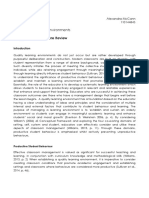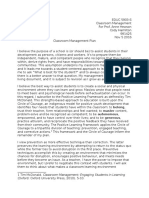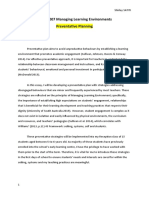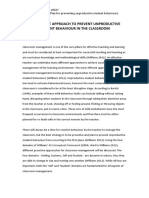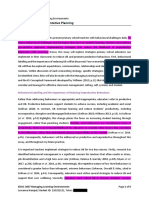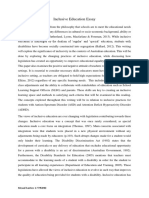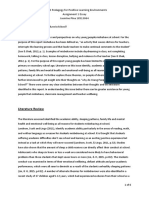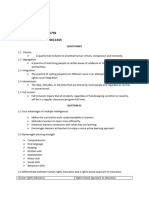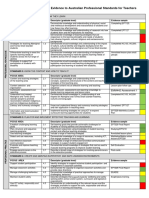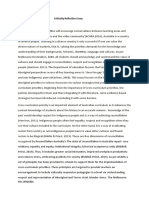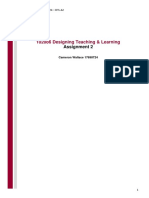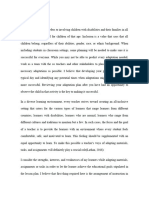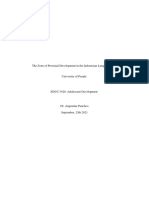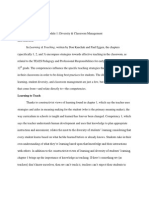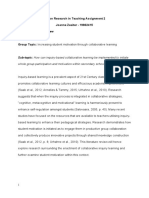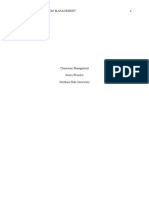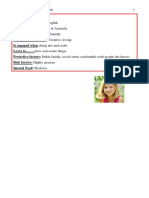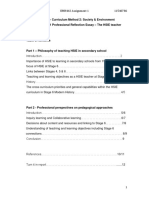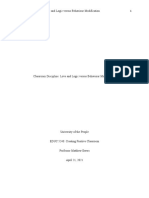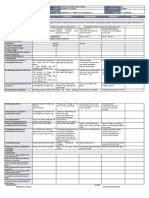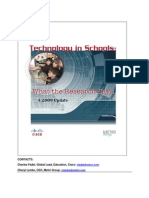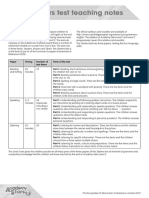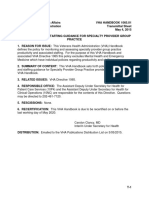EDS110 MANAGING THE LEARNING
ENVIRONMENT
Assessment 2: Case Study Report
Curtin University
UC: Giselle Mafa
Tutor: Justin Mortley
Tahlia Ghabiliha
20263524
0
�Table of Contents
Section One: Positive learning Framework Philosophy 2-4
a) The nature of children 2
b) Student’s abilities at various developmental stages 2-3
c) Student’s capacity for self-direction 3
d) How children react to different situations and treatments 3
e) The degree of control or coercion used by the teacher 3-4
f) The degree of choice the students are permitted 4
g) The role of the teacher 4
Section Two: Classroom Management Theory 5-6
a) Theory identification 5
h) Description of key points 5
i) Explanation of theory alignment with philosophy 5-6
Section Three: Positive Learning Framework Preventative Strategies 7-8
a) Connecting with students 6
j) Communication and directions 6
k) Classroom physical layout and resources 7
l) Expectations/rules/code of conduct 7
m) Routines and procedures 7
n) Catering for individuals and diverse socio-cultural student needs 8
o) Strategies for involving parents/carers in your teaching and learning 8
Section Four: Positive Learning Framework Corrective Strategies 9-10
References 11
1
�Section One: Positive Learning Framework Philosophy
Effective classroom management involves a philosophical, theoretical, and principled
framework constructed purposefully by teachers (McDonald, 2019). This report
demonstrates an individualised Positive Learning Framework plan (PLF) applied to
secondary level students (grades 7 to 12).
a) The inclusion of a personal philosophy within the PLF provides guidance when managing
classroom complexities. An individual perspective of the nature of children within
adolescence is:
Identity establishment peaks.
They need to be accepted and appreciated.
Theories that support this include the Circle of Courage (COC) (2009) which underpins
this PLF and pinpoints the children’s growth requirements of belonging, mastery,
independence, and generosity which will be mentioned throughout, thus providing a
foundation to mature positive classrooms. Erikson (1968) regards adolescence as a
period when identity formation begins, with unsuccessful establishment of a resilient
identity embedded in family, culture, or ideology resulting in problematic adulthood.
Additionally, Adler (1927) considered belonging and importance within a group to be a
human’s most essential socio-emotional necessity. The trusting ties formed between
adolescents and their family, school peers and mentors/teachers hold the most
developmental impact and is confirmed within Bronfenbrenner’s human ecology model
(McDonald, 2019).
b) Neurological research signifies that adolescent brain development presents potential
emergence of risky and impulsive behaviour (Duchesne & McMaugh, 2019). Healthy
brain development for secondary students is therefore critically dependent on teachers
as participants in creating positive environments that nurture such demands (McDonald,
2
� 2019). Secondary students’ abilities are within Piaget’s concrete- and formal-operational
levels and this philosophy aims to educate to ‘stage not age’. Accordingly, consilience is
evident here as Glasser’s management model also asserts the goal to cognitively
challenge students through successful encapsulation of interests and creation of
enthusiasm relevant to curriculum (Duchesne & McMaugh, 2019; Charles, 2013). Thus,
this philosophy promotes classrooms where tangible mastery experiences can exist.
c) Personal experience through raising children has created the belief that:
Children are born with the capacity to self-regulate and are inherently driven to
learn.
Bronfenbrenner’s model highlights that humans are ultimately shaped by their actions
and children are equipped with the potential to be active creators of their positive
development experiences. This PLF adapts that adolescents increased yearning for
autonomy requires quality learning environments where student personal accountability
and self-discipline is cultivated (McDonald, 2019). This provides another growth need of
independence.
d) Emanating from the Circle of Courage and egalitarian theories comes the personal
principle that:
Causes of misbehaviour are multifaceted.
The Coloroso philosophy can be pertained to such principle due to the key beliefs being
that ‘kids are worth it’ and to treat students with compassion, care and dignity if you as
an educator are wishing to be treated the same (McDonald, 2019). This approach also
aligns with Glasser’s and Curwin and Mendler’s theories as it demonstrates students’
behaviours as a reflection of unmet needs, rather than an immediate class disruption
(Lyons et al., 2011). This personal philosophy adapts the idea of concentrating on
preventative strategies, rather than corrective (Charles, 2013)
3
�e) Furthering on the individualised philosophy that students do have the power to self-
regulate and demonstrate responsible behaviour, Coloroso and Glasser provide
continued theoretical support through their views of empowerment and noncoercive
influence in the classroom (McDonald, 2019; Charles, 2013). The purpose of discipline
as defined by Coloroso is to build students capacity to manage their problems through
responsibility, acceptance, and dignified consequences. Moreover, Glasser (Charles,
2013) asserts that positive teacher influence is through use of lead management and this
supports the philosophy that a warm, encouraging classroom climate is essential in
meeting students’ foundational needs.
f) Unique experiences within parenting have assisted this PLF philosophy to demonstrate
the ultimate importance of:
Adolescents needing to be valued and respected.
Kohn’s Beyond Discipline theory presents support to this philosophy through its depiction
that students need to be provided autonomy in making choices within a caring classroom
community as achievement declines when educators do not allow student choice and
control over their learning. Value and respect can be provided to secondary students by
educators once again treating them as individuals with required needs and involving their
decisions in the classroom (Charles, 2013). A learning community where adolescents
are encouraged and feel safe to offer ideas results in kinder, more compassionate, and
self-fulfilled adults (McDonald, 2019).
g) Acting as a mediator of learning and classroom management the role of the teacher
pertaining to individualised philosophy is to ultimately build powerful strengths in
students within a classroom environment. An educator’s position involves being a mentor
through depiction of their expert knowledge and creating a classroom where students
essential needs are met.
4
� Section Two: Classroom Management Theory
a) Richard Curwin and Allen Mendler offer an egalitarian, needs-based classroom
management model titled ‘Discipline with Dignity’ which will be discussed further in
congruence with this PLF (McDonald, 2019).
b) Presenting a framework for educators to tackle student behaviour, ‘Discipline with
Dignity’ represents the fundamental principles of dignity, respect, and response to
student needs. Curwin and Mendler assert their beliefs that:
All students matter equally, and students destined to fail can be reclaimed through
instillation of hope.
Discipline techniques should never interfere with a student’s motivation to learn.
Dignity must always be provided to students within all interactions.
The core of discipline strategies is to educate children on how to be accountable
(Charles, 2013).
Ultimately, this theory is underpinned by the confidence of teacher-student
relationships and its importance within effective discipline. A challenge for all
educators to create classroom climates that make students feel welcome, safe,
inspired, and invigorated to flourish in responsibility is what Curwin and Mendler’s
framework provides (McDonald, 2019).
c) This egalitarian classroom management theory has alignment with the individualised
philosophy mentioned due to its promotion of teacher responsibility to always provide
a compassionate, supportive, and respectful classroom where all students feel
belonging. Moreover, ‘Discipline with Dignity’ supports personal beliefs that children
are born to self-regulate with promotion of autonomy and responsibility standing at
the core of all disciplinary measures (Charles, 2013). Treating all students with
5
� dignity involves being aware and concerned for their essential needs, thus aligning
with the COC and underpinning attitude of this PLF that there are no disposable
youth (McDonald, 2019).
Section Three: Positive Learning Framework Preventative Strategies
Preventative strategies are imperative in ensuring the reduction in misbehaviours as well as
the escalation of conflicts.
a) Students perform in a connected and cooperative way when they belong and feel
significant, therefore it is fundamental for educators to be empathetic, trusting, and
respectful to achieve this (Adler, 1927; McDonald 2019). Curwin and Mendler
(Charles, 2013) believe giving power to teacher-student relationships is valuable with
ways to connect with students being:
Smiling, using kind gestures, facial expressions, and tones of voice to acknowledge
students’ presence – especially returning absentees.
Remaining human; Apologising after mistakes and being silly/fun.
Utilisation of ‘thank you’ and ‘I appreciate you’ notes (McDonald, 2019).
b) Educators must create harmony between themselves and their students to foster
misbehaviour prevention that is built on the COC. Implementation of a cue to start,
clear learning outcomes, lesson linking and effective teaching questioning and
responding allows educators to show their respect for students’ self-discipline
abilities (McDonald, 2019). Additionally, Ginott’s (Charles, 2013) congruent
communication can forge this through:
Elimination of preaching, moralising, guilt imposing and demand promising
statements.
Expressing anger appropriately.
The use of brevity when correcting.
6
�c) To support in increasing student commitment to learning the layout and utilisation of
resources within a classroom is paramount. Establishing a caring teaching space
environment is the goal and this can be achieved by:
Furniture/digital devices being adaptable to rearrangement to support individual and
group work.
Exhibits of student projects (Charles, 2019; Parsons, 2016).
The educator being constantly on the move, weaving throughout the classroom –
rather than sitting as an authoritarian at the front.
d) Endeavouring to encourage wellbeing and continued accountability within the
classroom, student rules and expectations are essential and must be social
agreements that make sense and include collaboratively selected consequences that
are based on core values (Charles, 2013). As stated by Kohn (Charles, 2013)
misbehaviour and broken rules are not effectively dealt with in alignment with
student’s essential needs when they are punished, with maximisation of student
involvement regarding resolution of problems resulting in longer lasting and more
profound solutions.
e) Ongoing class routines and procedures are essential to decrease off-task behaviours
and disruption opportunities, thus enhance safety and autonomy within the learning
environment. Explanation of expectations within the first few days of the school year
is essential for effective establishment. Class routines/procedures can include:
Class line-up, roll call and bag storage location.
Class objective outline/resources/worksheet distribution.
Writing homework in diary before thank-you and goodbye (McDonald, 2019).
7
�f) Individual and diverse socio-cultural students within the classroom can be
challenging due to our brains seeing ‘difference’ as a likely threat, resulting in
educators holding possible conscious and unconscious bias and acting on
stereotypes. It is vital for teachers to:
Delve into how discipline at school and in their home and culture differs.
Survey and research the traditions, languages, interests, achievements, and
overall cultural background of such students (McDonald, 2019).
These tools allow connection with diverse socio-cultural students and consequently
make sure they feel valued.
g) Lastly, effective classroom management strongly results in working with parents.
Most parents want to feel comfortable and a sense of belonging in the
classroom/school and educators can achieve this through consistent open
communication that is meaningful and frequent through:
Class newsletters.
Brief individualised email/phone call updates.
Provision of community resources for parents seeking support (McDonald,
2019).
8
�Section Four: Positive Learning Framework Corrective Strategies
The use of dignity is essential within corrective actions for discipline to be effective. Curwin
and Mendler (Charles, 2013) state that effective discipline always offers hope. Dignified
corrective strategies are those that honour individual respect to students and demonstrate
understanding and concern about their needs and perspectives through privacy, politeness,
and a kind tone of voice (Charles, 2013).
Strategies to respond to low-level class interference include:
Non-verbal communication that include signals and gestures.
Tactical ignoring paired with recognition and reinforcement of positive behaviours.
Avoiding ‘why’ questions.
Use of minimal language with assertive tone, eye contact and question redirection
(McDonald, 2019)
Moderate-level corrective actions within this PLF include:
Empathetic statements that assist in diagnosing what has happened and why.
Identification of the student’s motivation and ‘game’ (McDonald, 2019)
Giving student’s choices or ‘Generic Consequence Planning’: Having students plan
out their consequences, thus giving students’ responsibility (Curwin et al., 2018)
The escalation responses include providing understanding once again about the
consequences discussed as well as implementation of such strategies. This may include
sending students to a ‘buddy class’, into isolation within the class or out of the classroom
altogether, however should still be communicated to him or her in a warm and regretful
tone (Charles, 2013). Finally, restorative corrective response within this PLF pertain to
providing students with the skills to re-connect, clarify, and restore the relationship
between yourself and the student, or student-to-student. Educators must first prioritise
assisting students in understanding what they did was wrong, why, and how to deter it
9
�from re-occurring. Restorative practices then follow this and are effective through
replacing, repairing, cleaning-up and/or apologising (Charles, 2013).
10
� References
Adler, A. (1927). Understanding human nature. Unwin Hyman.
Brendtro, L., & Brokenleg, M. (2009). Reclaiming youth at risk: Our hope for the future.
Solution Tree Press.
Charles, C. M. (2013). Building classroom discipline (11th ed.). Pearson.
Curwin, R. L., Mendler, A. N., & Mendler, B. D. (2018). Discipline with dignity: How to build
responsibility, relationships, and respect in your classroom (4th ed.). ASCD.
Duchesne, S., & McMaugh, A. (2019). Educational psychology for learning and
teaching (6th ed.). Cengage Learning.
Erikson, E. H. (1968). Identity: Youth and crisis. Norton, New York.
Lyons, G., Ford, M., & Arthur-Kelly, M. (2011). Classroom management: Creating positive
learning environments (3rd ed.). Cengage
Learning. https://www.sgcs.k12.in.us/userfiles/96/Classes/280/classroom
%20management%20theories%20pdf.pdf?id=2383
McDonald, T. (2019). Classroom management: Engaging students in learning (3rd ed.).
Oxford University Press, Australia.
Parsons, C. S. (2016). "Space and consequences": The influence of the roundtable
classroom design on student dialogue. Journal of Learning
Spaces, 5(2). https://files.eric.ed.gov/fulltext/EJ1152588.pdf
11

